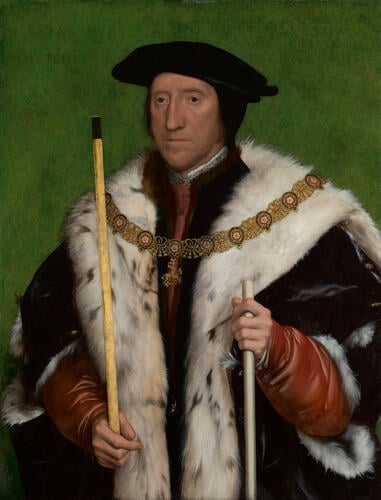-
1 of 253523 objects
Thomas Howard, Third Duke of Norfolk (1473-1554) c. 1539
Oil on panel | 80.1 x 61.4 cm (support, canvas/panel/stretcher external) | RCIN 404439
-
Thomas Howard, third Duke of Norfolk (1473-1554), was one of the most powerful nobles in the country. His first wife was Anne of York, the sister of Henry VII’s queen, Elizabeth of York. He was uncle to Anne Boleyn, Henry VIII’s second wife, and to Katherine Howard, Henry’s fifth wife. He was godfather to Prince Edward and married his daughter Mary to Henry’s illegitimate son Henry Fitzroy, Duke of Richmond. He was made a Knight of the Garter in April 1510 and Lord High Admiral in 1513; in September 1514 he escorted Henry VIII’s sister Mary to France for her marriage to Louis XII. He became Lord High Treasurer in 1522 and Earl Marshal in 1533. However, in 1546 he and his son, the poet Earl of Surrey, were imprisoned for high treason. His son was executed, but the Duke escaped because the King died the night before his appointed day of execution. He was imprisoned for six years, released by Queen Mary in 1553 and died the following year.
The three-quarter-length format is rare in Holbein’s work and the sitters in the few other examples that exist held the highest positions at court. The format gave the Duke a more imposing presence than in reality, since he was described by the Venetian ambassador as ‘small and spare in person’. Richly dressed, Norfolk holds the gold baton of Earl Marshal and the white staff of Lord High Treasurer, and wears the Order of the Garter.
Conservation has revealed the high quality of the portrait, in particular the unnerving realism of Norfolk’s expression. The inscription was probably in gold and has been partly removed. Cleaning and conservation have made it more decipherable. It is unlikely to be original, but was probably added early in the portrait’s history. It is in English rather than the Latin used for all other inscriptions on Holbein’s painted portraits. There must have been more modelling on the gold baton originally. The background is made up of a light greenish-yellow lower layer, with a rich green glaze over it which has worn away in places. A previous restoration covered this with an opaque toning layer which had discoloured. The rich green is once again revealed and is particularly vibrant around Norfolk’s shoulders and on the left side of the painting. Conservation has also revealed the extraordinary realism of the lynx fur, which is comparable with that worn by Jean de Dinteville in The Ambassadors (1533, National Gallery, London). The salmon pink preparatory layer, which Holbein used on other portraits at this date, gives warmth and life to Norfolk’s face.
Norfolk celebrated his family alliances with portraiture. Twenty-eight portraits are listed in his possession in 1547. This portrait may have belonged to the Duke’s great-great-grandson, Thomas Howard, Earl of Arundel, who was the greatest collector of Holbein’s work and proud of his ancestry. Among the several versions are two important ones at Arundel Castle and one at Castle Howard. The portrait is carefully depicted in the background of a watercolour by Philip Fruytiers of the Arundel family (1643, Arundel Castle), which may record a scheme by Van Dyck for a large family portrait. It also appears lower left in the memorial print of the deceased Earl by Wenceslaus Hollar, Allegory on the Death of the Earl of Arundel.
Catalogue entry adapted from The Northern Renaissance. Dürer to Holbein, London 2011Provenance
Thomas Howard, Earl of Arundel; bought from his heirs by Frederick, Prince of Wales, in 1744; seen at Leicester House by George Vertue in 1750; recorded in 1792 in the King's Closet at Windsor Castle, where it appears in Pyne's illustrated Royal Residences of 1819 (RCIN 922104).
-
Medium and techniques
Oil on panel
Measurements
80.1 x 61.4 cm (support, canvas/panel/stretcher external)
105.8 x 87.3 x 9.3 cm (frame, external)
